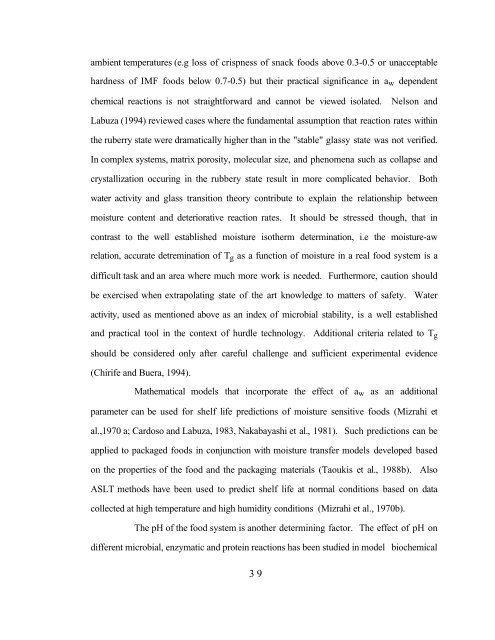the handbook of food engineering practice crc press chapter 10 ...
the handbook of food engineering practice crc press chapter 10 ...
the handbook of food engineering practice crc press chapter 10 ...
Create successful ePaper yourself
Turn your PDF publications into a flip-book with our unique Google optimized e-Paper software.
ambient temperatures (e.g loss <strong>of</strong> crispness <strong>of</strong> snack <strong>food</strong>s above 0.3-0.5 or unacceptable<br />
hardness <strong>of</strong> IMF <strong>food</strong>s below 0.7-0.5) but <strong>the</strong>ir practical significance in a w dependent<br />
chemical reactions is not straightforward and cannot be viewed isolated. Nelson and<br />
Labuza (1994) reviewed cases where <strong>the</strong> fundamental assumption that reaction rates within<br />
<strong>the</strong> ruberry state were dramatically higher than in <strong>the</strong> "stable" glassy state was not verified.<br />
In complex systems, matrix porosity, molecular size, and phenomena such as collapse and<br />
crystallization occuring in <strong>the</strong> rubbery state result in more complicated behavior. Both<br />
water activity and glass transition <strong>the</strong>ory contribute to explain <strong>the</strong> relationship between<br />
moisture content and deteriorative reaction rates. It should be stressed though, that in<br />
contrast to <strong>the</strong> well established moisture iso<strong>the</strong>rm determination, i.e <strong>the</strong> moisture-aw<br />
relation, accurate detremination <strong>of</strong> T g as a function <strong>of</strong> moisture in a real <strong>food</strong> system is a<br />
difficult task and an area where much more work is needed. Fur<strong>the</strong>rmore, caution should<br />
be exercised when extrapolating state <strong>of</strong> <strong>the</strong> art knowledge to matters <strong>of</strong> safety. Water<br />
activity, used as mentioned above as an index <strong>of</strong> microbial stability, is a well established<br />
and practical tool in <strong>the</strong> context <strong>of</strong> hurdle technology. Additional criteria related to T g<br />
should be considered only after careful challenge and sufficient experimental evidence<br />
(Chirife and Buera, 1994).<br />
Ma<strong>the</strong>matical models that incorporate <strong>the</strong> effect <strong>of</strong> a w as an additional<br />
parameter can be used for shelf life predictions <strong>of</strong> moisture sensitive <strong>food</strong>s (Mizrahi et<br />
al.,1970 a; Cardoso and Labuza, 1983, Nakabayashi et al., 1981). Such predictions can be<br />
applied to packaged <strong>food</strong>s in conjunction with moisture transfer models developed based<br />
on <strong>the</strong> properties <strong>of</strong> <strong>the</strong> <strong>food</strong> and <strong>the</strong> packaging materials (Taoukis et al., 1988b). Also<br />
ASLT methods have been used to predict shelf life at normal conditions based on data<br />
collected at high temperature and high humidity conditions (Mizrahi et al., 1970b).<br />
The pH <strong>of</strong> <strong>the</strong> <strong>food</strong> system is ano<strong>the</strong>r determining factor. The effect <strong>of</strong> pH on<br />
different microbial, enzymatic and protein reactions has been studied in model biochemical<br />
39














